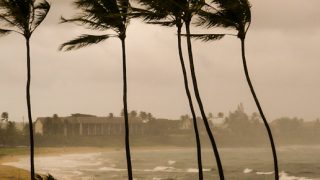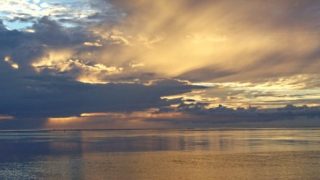It was just one year ago this week that we first wrote about Major Category 4 Hawaii Hurricane Darby, which was on track to be not far from the Hawaiian Islands. Like last year, Hurricane Calvin may be the first one of this year to enter the Central Pacific.
Another similarity at the moment is the prediction for a favorable pass-by next week as a significantly weakened tropical storm. Currently, moist and warm temperatures are conducive to additional strengthening. Calvin is expected to encounter conditions in another three days that will cause it to cool as wind shear and humidity decrease; a weakening trend should ensue.
For now, Calvin remains far from Hawaii, as it moves towards us from a position 2,000 miles away. Hurricane season in Hawaii just started last month and will be with us until December. So this is our own reminder, for visitors and residents alike, of what to do in Hawaii during the last half of every year.
Update: HTA Issues “Stay Prepared” Alert.
The alert came on Friday afternoon at 5:30 pm (HST). Hawaii Tourism Authority (HTA) advised, “We strongly urge all visitors and kama‘āina to remain vigilant.” Any possibility of a hurricane in Hawaii is taken seriously. On an island in the middle of the Pacific, you can’t escape a storm and drive to another island or state.
While we have confidence in the NOAA Weather Service forecast, what happened here in Hawaii during Hurricane Iniki always serves as a reminder that hurricanes can and do change plans suddenly and that predictions can go completely awry. At present, a likely tropical storm remnant may bring extensive rain to Hawaii early next week.
Why hurricanes are such a concern in Hawaii.
Hurricanes making landfall in the Hawaiian Islands remain rare. The last major hurricane to make a direct impact was over 30 years ago when Hurricane Iniki hit Kauai. Hurricanes in Hawaii, to those of us who live here and have witnessed the destruction, are always fresh in our minds. We are, after all, poised remotely in the Pacific with no place to escape such events.
Reflecting on Hurricane Iniki, NOAA’s Central Pacific Hurricane Center said previously, “Throughout the state of Hawaii, we must take note that the possibility of a hurricane in these islands is real. Heed the advice of public safety officials. Make a preparedness plan, and communicate it to your friends and family. Together, we can make our communities more weather-ready and resilient.”


2023 Hawaii Hurricane Season.
NOAA has been predicting a “50% chance of above-normal tropical cyclone activity during the central Pacific hurricane season this year.” That leaves “a 35% chance for near-normal activity, and only a 15% chance of a below-normal hurricane season.” For the year, 4 to 7 cyclones are predicted for our central Pacific hurricane basin, while a normal season would have fewer.
NOAA said that “Hurricane season in the central Pacific region is expected to be slightly busier this year, compared to a normal season.” El Nino contributes to an increase in hurricane and related storm activity in the Pacific. NOAA admonished us on something all too familiar, saying, “The last few hurricane seasons have been pretty quiet around Hawaii, luring some folks to let their guard down. Now it’s looking like this season will be more active than the past several years. It’s more important than ever to review your emergency plan and supply kit now, so you will be prepared for the next hurricane threat.”
NOAA has significantly improved hurricane technology.
Last year a new satellite was positioned that forecasters use to track and forecast tropical cyclones and other storms in the Pacific. NOAA has also improved its computing capacity for “more detailed, higher-resolution Earth Models that can handle larger ensembles, advanced physics, and improved data assimilation.” NOAA is now able to look further out by an additional two days, from five before to seven now, with these added capabilities.
Hawaii Travel Checklist For 2023 Pacific Hurricane Season
- Having some form of first aid kit is a must for any trip, regardless of the time of year. You can find great ones online or at stores, starting at under $10. We have them in our cars too.
- Make sure you pack essential medications with an ample supply, just in case something unexpected happens and your Hawaii vacation becomes unexpectedly extended.
- During your trip, it’s a good idea to have water and non-perishable food readily available. Whenever there’s even a remote possibility of a hurricane, stores in Hawaii run out of products more quickly than you can imagine.
- In the event of a hurricane entering the Central Pacific basin, some airlines allow changes to Hawaii vacation plans. It’s worth checking with your airline about their policies.
- Considering travel insurance is always a smart move, as it can offer protection for significant, non-refundable expenses. Remember you need to purchase the insurance before a specific hurricane develops in order to be covered.
- Keep your car’s gas tank at least half full or more, ensuring you have enough fuel in case of emergencies.
- It’s also a good idea to have some extra cash on hand for emergencies. In case of trouble, ATMs may not be working, so having spare cash can be a lifesaver even in today’s modern age.
And for us residents who live here in Hawaii.
- Make sure to keep your propane tanks filled to capacity. This will ensure you have an ample supply in case of emergencies.
- It’s a good idea to always have plastic tarps and plywood available for unexpected situations. They can come in handy when you need to secure or protect your surroundings.
- In case of water shortage, consider cleaning unused trash cans thoroughly and use them for storing drinking water.
- To be prepared, it’s best to have a larger stock of food supplies than usual. This way, you won’t have to worry about running out of essentials during unforeseen circumstances.
- Before the need arises, test your electric generator (we keep a new one ready) and ensure you have a working one. This will give you peace of mind with a reliable power source if necessary.
- Purchase some extra batteries before the need arises and consider a working radio. Yikes, we don’t have a radio any longer! These items can become essential for remaining connected and informed.
- Keep medical supplies readily available. Being prepared can make a significant difference in addressing any health-related situations that may arise.
Get Breaking Hawaii Travel News







Can you provide us with examples of panic that has happened this week?
Being prepared and panicking are two different things. Most people living on island prepare not panic.
“Hurricanes Cause Panic ….” – is panic in the title of this article really necessary? Despite the concern of a repeat of the impact of Iniki, you mention the preparation and the better NOAA forecasting available now with no reference to or evidence of anyone in a panic. Despite being in Maui multiple times when there is a hurricane warning, we have heard a lot of concern, but not seen or experienced anyone in a panic.
I want to know where do I go in case it hits Oahu? Also want to be updated with the information regarding the hurricane
So when over the last 5 years has the NOAA predictions about hurricanes or tropical storms in the Pacific basin been even remotely close? Modeling the weather is just about equivalent to trying to herd cats in that there are just too many variables to take into account to make truly accurate predictions. Why do you think that they have that huge “cone of uncertainty” as to where they think a hurricane might actually impact land!? They don’t know what they don’t know about how other factors in the atmosphere will impact their predictions.
Hope it does no harm to people but honestly for the new kona village the prices they are charging hope they get wiped out. No harm to people but I hope they have to pay for repairs for the amount they are charging. No middle class people can afford to stay there. It’s horrible
That’s still an awful wish to see people’s possessions destroyed. What’s happened in Kona or anywhere else is lots better than going the other way and end up blighted. Consider changing your view on that, it’s very mean.